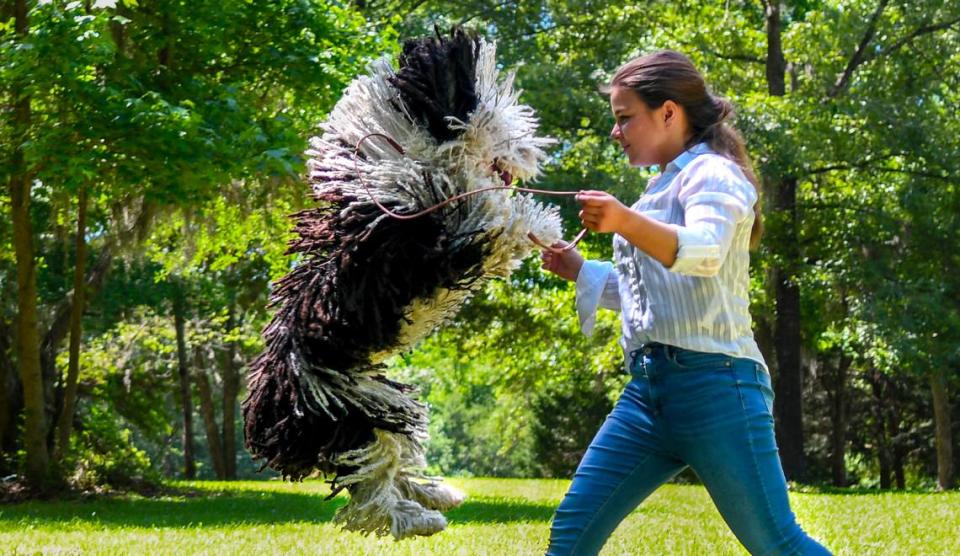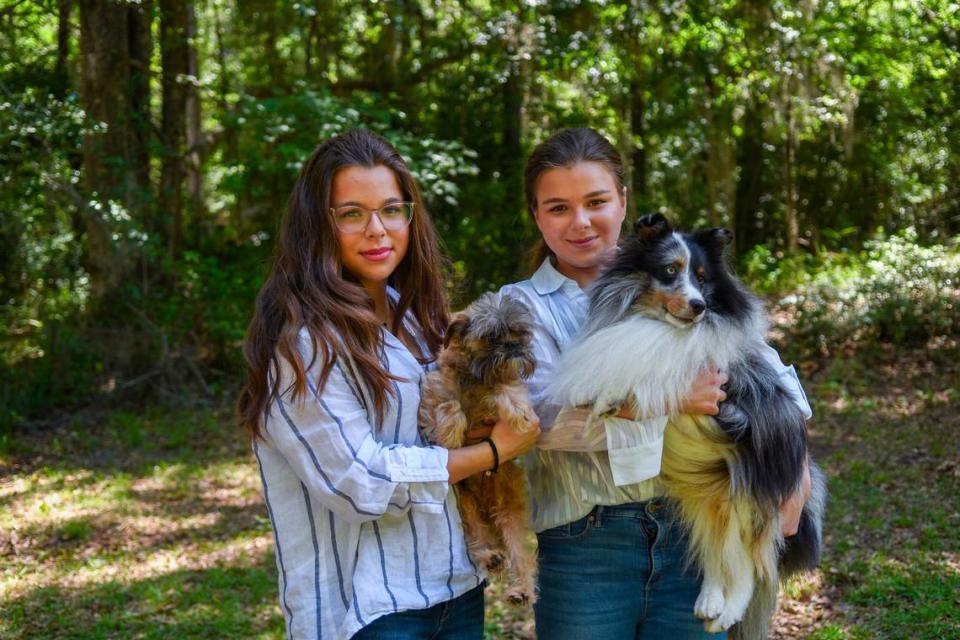Meet the Ridgeland twin teens with their love of dogs and the prestigious show business
Upholding a legacy over a century old, borne from minds of the Manhattan elite, doesn’t intimidate two teenagers living in the quietude of rural South Carolina. At this point, it’s routine for Addison and Kadence Lancaster.
Since they were 8, with the exception of a pandemic year, the Westminster Kennel Club Dog Show has been a highlight on the 15-year-olds’ packed calendars.
While it’s the most prestigious dog show they’ve competed in since August, it was one of 18 others on their docket in the past nine months. Westminster or not, preparation is exhaustive. The days are long. Logistics and strategy can get complicated.
When the teens begin to talk about their sport, everything from an affenpinscher’s eye shape to rankings as junior handlers, a whole world unravels. It’s one that many have heard of and few understand.
But for the twin sisters, it’s a world they’ve lived in since before they can remember. After all, it’s in their blood.
Making it to Westminster
In the Lancasters’ Ridgeland home, set back from winding roads and under the shade of oaks, three generations of dog handlers gather in the kitchen.
The twins were 8 when they first competed at a dog show, the girls’ grandmother, Janet Rahn, recalled, standing at the coffee maker.
“Weren’t we 6?” Kadence piped up from the kitchen table.
“No, 5,” Addison interjected, seated across from her sister.
At 5 years old the girls first showed a toy fox terrier in Charleston, their mother, Chelsy Lancaster, confirmed.
“The reason we had them is because they could lift them on the table,” Chelsy said. “They couldn’t physically lift something larger.”
Then, mostly exhilarated and well-prepared, they entered the ring on their own in matching blue dresses to start making a name for themselves. By 6, Addison showed a German shepherd. At 8, they headed to Westminster. Now, turning 16 in a month, they compete in different breed groups and have graduated to prim knee-length skirts and modest blazers.
Over a decade into the sport, they’ve shown about 100 different breeds while learning how to be a handler by assisting other professional handlers. They’ve won countless awards. Putting an exact number on how many shows they’ve gone to is difficult. Most recently, Kadence nabbed best of breed at Westminster with Hef, a Spanish water dog.

Instead of chatting about typical teenage woes, complaining about homework or gushing over crushes, the two, still with teen spirit, are all business. They explain what “fitting the best standard” means — the culmination of the dog’s attributes like height, face shape, teeth, temperament and balance. The closer the dog is to a judge’s perfect image of that breed, the more points are awarded. They talk strategy — how to rack up enough points to be top five in their chosen breed or how to get at least seven-best wins as junior handlers. Both are tickets to Westminster.
Every event throws out a new challenge. Crowds can be small or in the thousands. Each venue has different acoustics. The surface below the dogs’ paws changes, everything from dirt and grass to floor mats.
Sometimes the Lancasters are up against 15 juniors, other shows they have to beat out 50 people. Competition can be cutthroat and some competitors they’ve known since they began the sport. While Addison and Kadence are technically each other’s competition in junior showmanship and compete against hundreds of others, the identical twins couldn’t be more different.
One minute older than her sister, Addison owns the 60-second difference with pride. Shows have never made her nervous and she prefers to be left alone during them. She favors showing toy breeds, which can be more difficult to train, like her 4-year-old affenpinscher Max.
Over time, Kadence has worked to calm her nerves during shows. She’s fine with the social aspect of the events, people gathering around her and helping out younger junior handlers. Herding breeds are her preferred dogs, which are calmer, just like 3-year-old Hef.
But even if someone doesn’t know the Lancaster sisters, Addison’s made it easy to differentiate between them: She’s the one in the acetate glasses.
Set up for success
The Lancasters’ road to Westminster was paved before Addison and Kadence were born.
Their grandmother, Janet, started the legacy decades ago and is a co-owner of Dog Gone Sensational, a kennel, day care and dog-grooming facility that’s part of the 30-acre farm. She’s an expert behaviorist and handler. Among her accolades are an appearance on the “The Late Show with David Letterman” and a national tour with the Purina Performance Team.
She’s long been a part of the nation’s most prestigious dog show with roots that date back to 1877. A group of sporting gentlemen, who’d meet at a Manhattan bar inside a hotel named Westminster, thought it was due time to form a club where they’d keep and train their hunting dogs. Thus was formed the Westminster Kennel Club. The first show was staged to “compare their dogs in a setting away from the field,” at Gilmore’s Garden, as the club’s history goes.
Westminster is the second-oldest continuously held sporting event in the nation, just two short years after the Kentucky Derby.
Throughout its history, a cast of characters vied for a top spot at the dog show. A Russian Czar who bred a Siberian wolfhound. General George Custer’s pack and two deerhounds that were bred by the Queen of England. Philanthropist J. P. Morgan who first showed his collies in 1893. A year later, American journalist Nellie Bly entered her maltese.
Now, nearly a century-and-a-half later, Addison and Kadence continue long-held traditions that require a certain professionalism, patience and preparation that’s learned from years of being mentored. One of those is a few steps away from home — their grandmother. The other is over 200 miles away — dog handler Lexy Jessee, who lives in Florida.
The Lancasters breed, train, groom and show their dogs. It’s all on a tight timeline, one that Chelsy tracks meticulously — everything from an upcoming show in Florida to planning which of their 3-week-old boykin spaniel litter of 10 will make it as show dogs. It’s detailed out on a color-coded calendar drawn onto a chalkboard-wall in the kitchen.

Planning to breed specific dogs takes years. Training can be monthslong. Grooming can run up hours. And despite an all-day event, showing a dog in front of a judge is a brief 2-minute window.
It’s further complicated by the fact that once a show dog, not always a show dog. The dogs can cycle in and out of the show scene, in between they’re well-trained house dogs that live in the lap of luxury. Addison and Kadence train and show new breeds often, learning about the specific best standard. It’s a way for juniors to learn about different breeds through immersion.
The dog “might be with them for a year or the weekend,” Chelsy said. “And then they go back home.”
Don’t they get attached? Yes and no. There’s always the “lifers.”
Lap of luxury
Humphrey, a 6-year-old affenpinscher, lovingly called “chicken nugget,” is a lifer at the Lancaster home.
He’s unlike his fellow housemates, like 6-year-old chihuahua Buzz that gets chalk applied to his face to keep it bright white, or Max that has expertly brushed and hair-sprayed fur around his face to balance his proportions.
While show dogs still get to sleep in Addison and Kadence’s beds at night and curl up in the air conditioning, lifers stay on the farm indefinitely and can get away with breaking rules. During Christmastime, Humphrey got to sport a green fur coat and wear a red sweater.

He’s a clear family pet. But getting into dog showing is knowing most dogs will eventually go home.
“We’ve had a lot of dogs that we have placed that were wonderful show dogs but again, you only want them to have a show career for so long,” Chelsy said. “Instead of them being in a kennel, they get to go be on somebody’s sofa.”
A few in Bluffton now cruise on boats. Others on Spring Island have become golf cart riders. That’s not to say dogs on the show scene aren’t spoiled in their own ways. They have their own chiropractors, weekly beauty sessions and have their teeth cleaned with a fancy gadget that’s similar to a Waterpik.
For any of the Lancasters’ show dogs, on the circuit, back with another family or retired, it’s certainly not a dog’s life.
But it is Addison and Kadence’s world.


